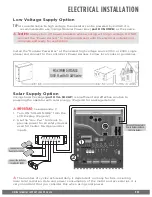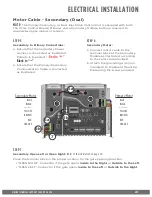
VIKING TECHNICAL SUPPORT 1.800.908.0884
3 3
Guidelines for Loop Installation
ACCESSORY CONNECTIONS
1. Prevent sharp corners in the geometry of the loop sensor.
2. Install the appropriate number of turns for your loop geometry based on the loop
perimeter. Use the Table below as a guide.
3. Use XLP (cross-linked-polyethylene) type of wire. This wire reduces the effects
of moisture and other environmental events in altering the functionality of the
vehicular loop detector.
4. Twist the lead wire at least 6 turns per foot.
5. Use BACKER-ROD to minimize damage to the loop detector wire prior to using the
sealant.
6. Place the loop detector wire and adjust the sensitivity of the vehicular loop
detector unit as needed.
5'
5'
5'
A
A
5'
Gate in Open Position
Inside
Re-Open
Loop
Center
Loop
Outside
Re-Open
Loop
Exit
Loop
Make Even
with Open Gate
Dimension “A” = 5’ for Single Gate
6’ for Dual Gate
Twist Wire Outside the
Loop 6 Twists/Foot
Until Its Connection
to the Loop Detector
1/8" to 1/4" Saw Slot
Provide Additional Saw Cuts
to Eliminate Sharp Corners
Continuously Wind Wire in Loop Slot
for the Required Number of Loops
Recommended Number of Turns
Perimeter (ft.)
Turns
10
5
20
4
30-40
3
50-100
2
1" Min.
Backer-Rod
Vehicular Loop
Detector Wire
(3 Turns Shown)
Sealant
Saw Cut
!
IMPORTANT!
Some of the following
parameters may affect the proper functionality
of the vehicular loop detector.
Consult the manufacturer of the vehicular loop
detector and/or loop wire.
• Gate size
• Number of turns in the loop sensor wire
• Distance of the loop sensor wire to the gate at
either at the open or close position
















































